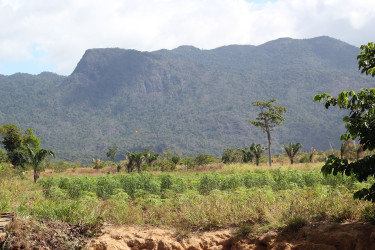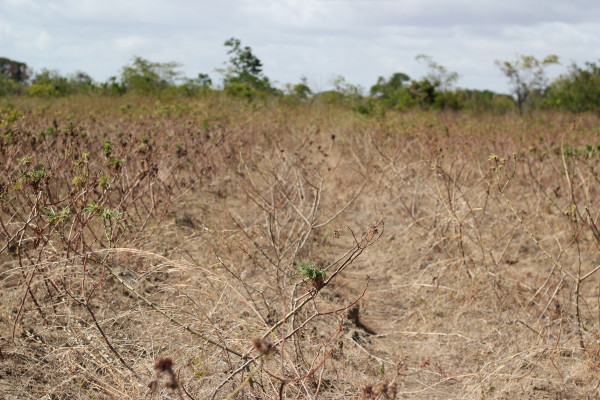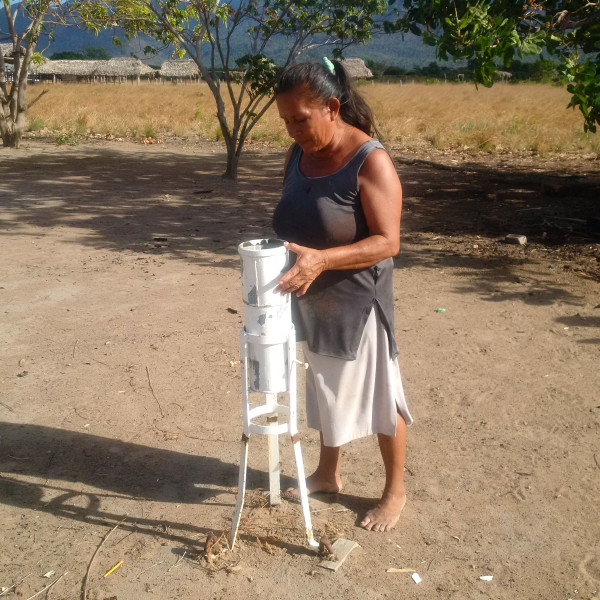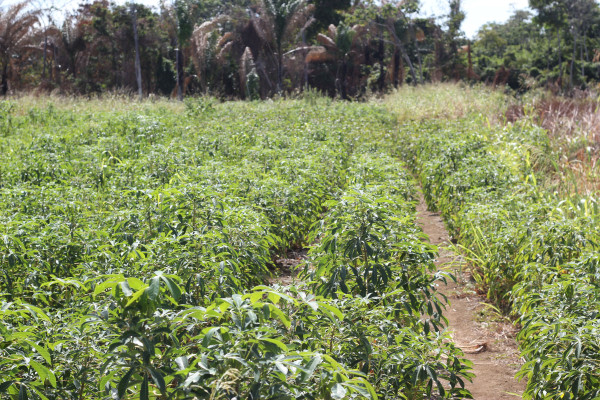Last month, as her cassava crop wilted in the unforgiving heat, Marlene Mandokin descended from her farm in the forests at the foot of the Kanuku Mountains and cleared a small plot of savannah close to the Moco Moco creek, hoping the water there would be enough to cultivate new crops.

“All our produce, all dry up,” she lamented, checking the empty rain gauge in her yard, the heat from the sun wilting the leaves on orange trees in her yard in Moco Moco, Region Nine recently. “Our cassava getting soft in the middle,” she said, describing the tuber as “corky” which essentially means that the cassava gets dry and soft when it should normally be firm and have ample moisture.
The “corkiness” of the cassava crop has been reported elsewhere in the vast savannah region as a prolonged dry season linked to El Nino weather phenomenon bakes the Rupununi. Rivers, creeks, lakes, ponds and wells have dried up, crops have died or are dying and livestock roam miles in search of water.
“I’ve visited the farms, sometimes you only see sticks, no leaves in these farms, all the leaves drop off so we know we’ll have a food shortage,” Region Nine Chairman Bryan Allicock told Stabroek News in an interview. The climate is changing he said, citing reports from scientists. Each year, the dry spells in the Rupununi are getting longer and there is need for long-term solutions, he asserted.
Allicock said that the mainly indigenous population in communities scattered across the Rupununi have not changed much of their cultivation practices and continue to base their planting on the weather.
However, in the communities close to the Kanukus, farmers have begun a slow migration from the forest “highlands” at the lower part of the mountains to the savannah “lowlands,” –swamps that usually flood and which were thought to be unsuitable for planting. But with longer dry spells, the swamps have dried and the soils have been discovered to be rich in nutrients.
At Nappi, acres and acres of cassava in various stages of growth, add green to the brown savannah grass.
A well-worn blue cap providing the only shade from the blazing sun, Nicodemus Joseph pulled cassava from the ground at his farm in the savannah. “It usually get flood but this year like it din get flood,” he observed.
He related that he has a one-acre farm in the highland but there is no water there at the moment. “Even in the bush in the mountain foot, the orange dry, dry,” he said. He normally farms in the forest but due to the lack of water and the fact that his cassava crop there has become corky, he moved.
Joseph said that he first farmed in the savannah in 2014 but that year, floods ruined the crop. Last year, he returned and it was better but then the dry spell started. He planted more cassava in the savannah this year but with the prolonged dry season, some of the younger plants were wilting and he was worried.
The farmer said he decided to grow his crops in the swamps because of the changing weather patterns and now most farmers from Nappi are engaged in savannah farming. “They never used to do savannah farming,” he observed, pointing out that farming was usually done only in the forests.
He said that the first farmers who grew crops in the savannah were peanut farmers who planted cassava between the peanuts and these grew well. This was around 2010, he said. Following successive crops, the fertility of the soil was established and as the seasons got drier, more and more persons moved to the now-dry swamps and focused on cassava. Even when the rains come now, Joseph said, the water moves off quickly.
Because of the flat land and the fact that there are no trees to clear, the Nappi farmers are making greater use of technology and use a tractor to plough the land and shape the soil into beds for the young plants. This has proven useful, as even in times of heavy rain, the crops are above the water line, Joseph said. He related how one man did not make beds for his cassava, and the crop was destroyed during a flood but now, he is shaping the soil into beds. It costs $18,000 per acre to plough and make the beds, Joseph related.
The farmer said that farming is easier in the lowlands because there is no forest to clear and the road is better and transport easier. He pointed out that during the rainy season, the trails in the forest become very muddy. He also said that while in the highlands, the soil is looser, in the flatlands, there is more of a mixture. “It’s fertile here,” he said.
In her highland farm at Moco Moco, Mandokin cultivated bitter cassava, sweet cassava, eddoes, and bananas, among other crops. “The sun get the ground hot, hot, hot,” she lamented. “Water all dry where I does get water from.” So she moved.
Mandokin established a small garden close to the Moco Moco Creek and now plants bora, ochro and red peas. These are growing well, she said, even as she pointed out that she waters the plants in the mornings and afternoons with water from the creek. “We don’t normally plant on the flat (land) because of the water too,” she said referring to floods.
Deputy Toshao of Moco Moco William Ramsarran said in the dry season now, farmers move to the lowlands and reap before the rainy season and the floods it brings. “The whole village getting into it now,” he said. “We have to really follow this pattern and work with the weather.”








